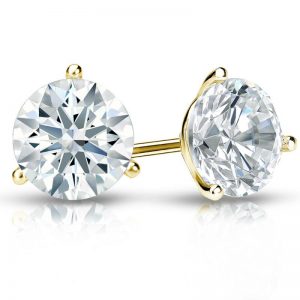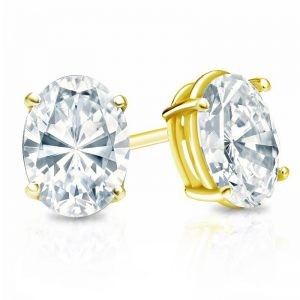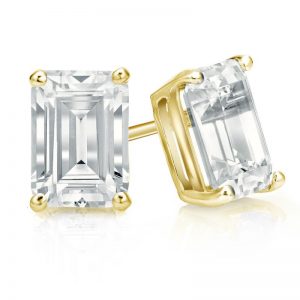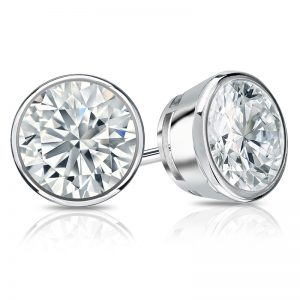
Settings for Diamond Earrings
There are different types of settings available, and the most popular are prong settings and bezel settings. Generally, bezels are more secure as they hold the diamonds by encircling them within a metal band.
The downside to bezel settings is that they also hide more of the diamond compared with prong settings. Prongs are less safe as they can bend or break more easily, but they leave more of the stone visible.
For added sparkle opt for a halo setting. A diamond halo will help to enhance earrings with a lower carat weight.
Regardless of your choice, you should make sure that the structure of the earrings is sturdy enough and doesn’t look like it is going to fall apart easily.

1 Choosing Metal for Earrings
Settings hold the diamond in place. Yellow Gold are popular choices and stand out against darker skin and hair. Silver, White Gold and platinum settings pair well with lighter skin tones and hair colours. Try on the earrings and compare them to your features so you find the one that looks best on you.
It’s worth knowing that there is a difference in the durability of different metals. For example, yellow gold is usually softer than white gold (which is usually a blend of gold and other metals), so consider how much you’ll be wearing the earrings occasionally or every day.
When buying gold, you’ll also see a number next to it, most commonly “14k” or “18k.” Pure gold is too soft for everyday wear so gold is usually mixed with other metals to make it more durable. The higher the karat, the higher the percentage of gold in the metal. 24k would be 100% gold, 18k is 75% gold, and 14k gold is 53.8% gold. So, when choosing your karat, know that a higher karat means that there is more gold in the metal but also know that that means that it would be more easily scratched.
If you are set on gold, whether white or yellow, ask if the earrings contain nickel – which some people are allergic to. Request low nickel content if you have sensitivity to this metal. You’ll know which colour you prefer, but as a general rule, yellow gold complements darker skin tones, whereas white metals are a better match for lighter skins.
When buying gold, you’ll also see a number next to it, most commonly “14k” or “18k.” This is the karat of the metal. Gold karat is a label that tells you what percentage of pure gold is in your metal. Pure gold is too soft for everyday wear so gold is usually mixed with other metals to make it more durable. The higher the karat, the greater the percentage of gold in the metal. 24k would be 100% gold, 18k is 75% gold, and 14k gold is 53.8% gold. So, when choosing your karat, know that a higher karat means that there is more gold in the metal, but also be aware that it would be more easily scratched.
If you’re looking for something that’s really unique, rose gold and black rhodium make interesting and unusual coloured settings for diamond stud earrings
Silver, while inexpensive, is as easy to scratch as pure gold and is prone to tarnishing. Like white gold, silver is often mixed with another metal to make it a little stronger.
Platinum has the advantage of being extremely durable. It is an incredibly hard metal and is far less likely to scratch or bend than other metals.
Though white gold resists scratches better, any scratches it obtains are permanent. Scratches on platinum cause a patina to form, which can be reversed by polishing, making platinum the winner in terms of durability although it does cost more. However gold comes in a wider range of colours, including yellow gold, white gold, and rose gold. The shade of gold you pick depends on your personal style. However, platinum is heavier and more expensive, so factor that in when making a decision.

2 Choosing Settings for Earrings
Pick smaller settings to make diamonds more visible. Metal settings also come in many different styles. The most common style is prongs, which simply put are little metal arms that hold the diamond in place. Prongs generally reveal more of the diamond than bezel settings, allowing more of the stone to be visible. This may allow more light into the diamond, enabling it to sparkle more, and appear a bit larger. Prongs are a beautiful setting but they do require a bit more upkeep. You’ll want to occasionally get the setting checked to make sure the prongs do not slip out of place, resulting in the potential loss of your stone. Settings with more prongs provide more security, but those with fewer prongs show off the diamond better. In addition to prongs, there are martini-style and basket-style settings that show off the diamond without full support.
Bezels are the other common setting type. The metal surrounds the edge of the diamond, keeping it secure, generally showing only the top of the diamond. This provides the diamond with greater protection from any wear and tear, as well as greater security from being dislodged. The drawback is that the metal covers more of the diamond, so that expensive beauty you purchased might be hidden behind a less appealing chunk of metal. The crown-style setting is similar but more ornate because it is shaped like a crown.
For added sparkle opt for a halo setting. A diamond halo will help to enhance earrings with a lower carat weight. [
Regardless of your choice, you should make sure that the structure of the earrings is sound.

3 Choosing Backings for Earrings
All that’s left for you to do is find a way to hold your studs in your ears. If you are purchasing diamond studs as a gift, make sure you know what type of earring backs your loved one prefers. If you can, check their jewellery box or the earrings that they commonly wear to find out. If you can’t check without ruining the surprise, push buttons or butterflies are a safe choice for earring backs.
Select push buttons or butterflies for ease of use. In general, they are the most popular earring back style on the market, because they are easy to use and comfortable for sensitive ears. Push buttons or butterflies are the most popular choice for this. Push them into your earlobes and you’ll be ready for a night out. They’re simple and easy on sensitive skin.
Pick clip or lever backs for comfort and security. These backs have small bars that secure the earring behind your ear. They’re much safer than push backs for more expensive pieces. Clips can pinch your skin, causing pain when you keep the earrings in too long. Lever backs are flatter and typically more comfortable than clips.
Get screw backs for the most security. Screw backs are far more difficult to get in and that’s why they can hurt your poor earlobes. The backings are thick and require effort to get into place. If your ears can handle it, the extra security is worth it!
Having said all of that, in the end it’s simple – choose jewellery that you love (or that you hope your loved one will love!)

